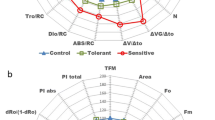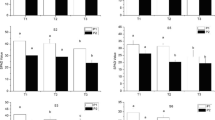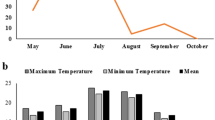Abstract
Potato (Solanum tuberosum L. cv. Russet Burbank) tuber periderm resistance to water loss was monitored during the harvest season. Periderm resistance of tubers from water-stressed plants was compared with tubers from unstressed plants throughout a six-week harvest period, in order to determine the effect of plant condition on tuber resistance to water loss. Tubers stored for ten days at 4°C immediately following harvest were also monitored to determine if storage enhanced periderm resistance and if any difference occurred between tubers from stressed vines compared with those from unstressed vines.
During the harvest season, tuber resistance to water loss was positively correlated with plant water stress, as measured by leaf water potential and leaf diffusive resistance. Storage of tubers after harvest also caused an increase in periderm resistance. The commercial practice of vine killing, therefore, may have a positive effect on reducing weight loss in storage by enhancing the resistance of tuber periderm to water loss.
Resumen
La resistencia a la pérdida de agua de la peridermis del tubérculo fue medida en la papa (Solanum tuberosum L. cv. Russet Burbank) durante la época de cosecha. La resistencia de la peridermis de tubérculos provenientes de plantas sometidas a estrés por falta de agua, fue comparada con la de tubérculos provenientes de plantas no sometidas a dicho estrés durante seis semanas en la cosecha, con el objeto de determinar el efecto del estado de la planta sobre la resistencia a la pérdida de agua por parte de los tubérculos. Los tubérculos almacenados durante diez dias a 4°C inmediatamente después de la cosecha, fueron asimismo, estudiados para determinar si el almacenamiento acrecentaba la resistencia de la peridermis y se presentaba alguna diferencia entre tubérculos de plantas sometidas a estrés por falta de agua y de plantas no sometidas a ese estrés.
Durante la época de cosecha, la resistencia de los tubérculos a la pérdida de agua resultó positivamente correlacionada con el estrés por falta de agua en las plantas, medido como potencial de agua en las hojas y como resistencia de las hojas a la difusión. El almacenamiento de tubérculos después de la cosecha acrecentó la resistencia de la peridermis. Por lo tanto, la práctica comercial de matar el follaje puede tener un efecto positivo en reducir la pérdida de peso durante el almacenamiento al acrecentar la resistencia de la peridermis de los tubérculos a la pérdida de agua.
Similar content being viewed by others
Literature Cited
Ackerson, R.C., D.R. Krieg, T.D. Miller and R.G. Sterens. 1977. Water relations and physiological activity of potatoes. J Am Soc Hortic Sci 102:572–575.
Artschwager, E. 1924. Studies on the potato tuber. J Agric Res 27:809–835.
Findlen, H. and A.H. Glaves. 1964. Vine killing in relation to maturity of Red River Valley potatoes. United States Department of Agriculture Technical Bulletin 1306.
Gander, P.W. and C.B. Tanner. 1976. Leaf growth, tuber growth, and water potentials in potatoes. Crop Sci 16:354–358.
Hope, G.W., D.C. Mackay and L.R. Townsend. 1960. The effect of harvest date and the rate of nitrogen fertilization on the maturity, yield, and chipping quality of potatoes. Am Potato J 37:28–33.
Kolattukudy, P.E. and B.B. Dean. 1974. Structure, gas Chromatographie measurement, and function of suberin synthesized by potato tuber tissue slices. Plant Physiol 54:116–121.
Maurer, A.R. and G.W. Eaton. 1971. Calculation of potato tuber surface area. Am Potato J 47:82–87.
Murphy, H. 1968. Potato vine killing. Am Potato J 45:472–478.
Nielsen, N.K. 1968. An investigation of the regenerative power of periderm in potato tubers after wounding. Acta Agric Scand 18:113–120.
Terman, G.L., C.E. Cunningham and M. Goven. 1952. Effect of date and method of kill on yield, specific gravity and other quality factors of Maine potatoes. Am Potato J 29: 279–289.
Schippers, P.A. 1976. Biological characteristics of the potato in relationship to storage.In The Potato Storage: Design, Construction, Handling and Environmental Control. Editor, B.F. Cargill. Michigan State Univ Press, p. 47–62.
van Loon, C.D. 1981. The effect of water stress on potato growth, development, and yield. Am Potato J 58:51–69.
Wilcockson, S. J., R.L. Griffith and E.J. Allen. 1980. Effects of maturity on susceptibility to damage. Ann Appl Biol 96:349–353.
Yamaguchi, M., H. Timm, M.D. Cless and F.D. Howard. 1966. Effects of stage of maturity and postharvest conditions on sugar conversion and chip quality of potato tubers. Proc. Am Soc Hortic Sci 89:456–463.
Author information
Authors and Affiliations
Additional information
Scientific Paper No. SP 6526. College of Agriculture Research Center, Washington State University, Pullman, WA 99164-6414. Project No. 0487.
Former Graduate Research Assistant.
Rights and permissions
About this article
Cite this article
Braue, C.A., Wample, R.L., Kolattukudy, P.E. et al. Relationship of potato tuber periderm resistance to plant water status. American Potato Journal 60, 827–837 (1983). https://doi.org/10.1007/BF02853972
Received:
Accepted:
Issue Date:
DOI: https://doi.org/10.1007/BF02853972




